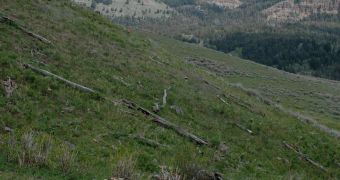Throughout the Yellowstone National Park, skeletons of dead animals permeate the landscape. In addition to adding charm to the place, they may also help experts determine what types of animal populations existed here in the past, and how many of the creatures were there.
Under the Sun, the bones appear white, making it easier for researchers at the Wright State University (WSU), in Dayton, Ohio, to find them. They say that the bones provide them with detailed accounts on animals that lived in Yellowstone decades to centuries ago.
Investigating this is becoming very important in light of the fact that a number of factors are altering ecosystems all over the world. Some of these factors include global warming, climate change, habitat intrusions, overfishing, excessive harvesting and so on.
In a paper published in the latest issue of the peer-reviewed scientific journal PLoS ONE, WSU biology expert Joshua Miller explains that knowing what happened in Yellowstone long ago provides a deeper context in which to analyze the changes the world is going through today.
“The skeletons of long-dead animals lying on landscapes provide critical insights into our understanding of ecosystem history, especially how populations have changed,” Miller explains.
“These changes result in population reductions and extinctions of some species, while others expand and invade new habitats and regions,” adds the expert, who largely conducted the research while a PhD student at the University of Chicago.
He goes on to explain that not many ecosystems in general were analyzed over prolonged periods of time. This area of science appeared rather recently, and soon experts realized the lack of reliable data detailing what happened at each ecosystem in the past.
This “hampers the ability of wildlife managers and other scientists to properly document or mediate these dramatic ecological changes,” Miller says, adding that studies such as this one should most likely be conducted wherever they are needed.
During his investigations, he surveyed skeletons of ungulates (hoofed animals), and then compared the data he obtained in this manner with existing surveys of species still living in Yellowstone. He found that all animals represented in the skeleton record were still alive today.
He also learned that the most abundant animals today are the same as the most abundant ones centuries ago, which hints at the fact that this particular ecosystems largely maintained its integrity.
“While the fossil record yields valuable insights into ancient ecological communities, understanding community change over the time scale of centuries has been difficult,” explains Saran Twombly.
“Here, clever use of vertebrate death assemblages in Yellowstone provides clear evidence of species shifts over the past century or more,” she adds. Twombly is a program director at the US National Science Foundation (NSF) Division of Environmental Biology (DEB).
“This technique extends our ability to document long-term changes in ecological communities--an ability of growing importance as global change, habitat destruction and anthropogenic disturbance alter ecosystems at increasing rates,” the expert concludes.

 14 DAY TRIAL //
14 DAY TRIAL //